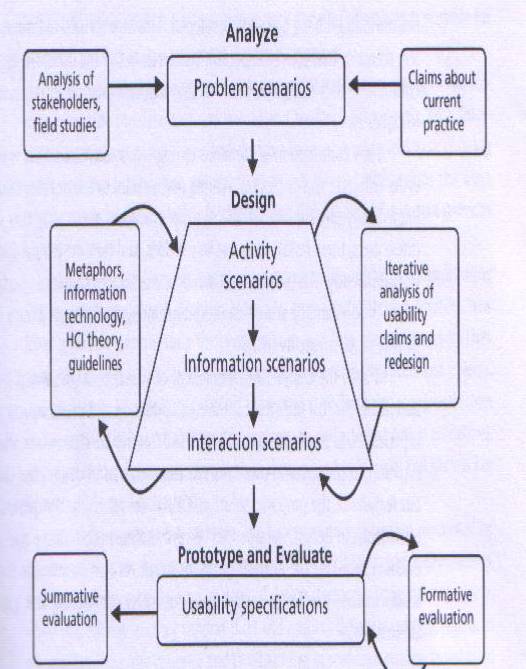Scenario-based usability engineering
Definition
Scenario-based Usability Engineering (SUNA) is a design methodology.
An example use case in educational technology is the e-framework for which Chris Fowler made a presentation.
Scenario-based design elaborates a traditional theme in human factors and ergonomics, namely, the principle that human charac- teristics and needs should be pivotal considerations in the design of tools and artifacts. In scenario-based design, descriptions of usage situations become more than just orienting examples and background data, they become first-class design objects. Scenario-based design takes literally the adage that a tool is what people can do with it - the consequences it has for them and for their activities that use it (Beth and Carroll, 2002).
User needs analysis
The basic steps in needs analysis is to define a scenario:
- It must be a narrative (story)
- It should have a precise scope (like a real story) and a time-frame
- It should describe:
- actors
- activities (tasks). What they do.
- things (objects) used
In addition, there should be a purpose to the story for the design process, e.g.
- communication
- analysis/design
- decision-making
Therefore a scenario can describe:
- a current "as is" situation (what people do, see above). This will help problem analysis
- a future proposed situation and also "what happens if" situations. This will help to build representations, i.e. a paper-based prototye of a design.
These narratives are constructed in an iterative process:
Links
- Fowler Chris, Scenario-based design, PPT slides, Chimera: Institute of Social and Technical Change, University of Essex. The initial version of this entry is based on these.
References
- Fowler, C.J.H, van Helvert, J; Gardner, M.G, and Scott, J.R. (in press). The use of scenarios in designing and delivering learning systems. In H. Beetham & R. Sharpe, Rethinking Pedagogy in a Digital Age: Designing and delivering e-learning. London: Routledge.
- Carroll, J.M (1995) Introduction: The Scenario Perspective on System Development. In J.M. Carroll (ed.) Scenario-Based Design: Envisioning work and Technology in System Development New York: Wiley
- Hutt, A.T.H., Donnelly, N., Macaulay, L.A., Fowler, C.J.H., & Twigger, D. (1988) Describing a product opportunity : A method for understanding the users' environment. In D. Diaper & R. Winder (eds). People & Computers III. Cambridge: CUP.
- Rosson, M.B. and Carroll, J.M. (2002) Usability Engineering: Scenario-based Development of Human-Computer Interaction. London: Academic Press.
- Rosson, Mary Beth and John M. Carroll (2002), Scenario-based usability engineering, Proceedings of the conference on Designing interactive systems: processes, practices, methods, and techniques. http://doi.acm.org/10.1145/778712.778776 (PDF)
- Rosson, M. B., Carrol, J. M., and Rodi, C. 2004a. Case studies for teaching usability engineering. In Proceedings of the 35th SIGCSE Technical Symposium on Computer Science Education (Norfolk, VA, March 3-7, 2004). ACM Press, New York, 36-40.
- Rosson, M. B., Carrol, J. M., and Rodi, C. 2004b. Teaching computer scientists to make use. In Putting Scenarios Into Practice: The State of the Art in Scenarios and Use Cases. I. F. Alexander and N. Maiden (eds.). John Wiley, New York.
- Carroll, John M. and Mary Beth Rosson, A Case Library for Teaching Usability Engineering: Design Rationale, Development, and Classroom Experience, ACM Journal on Educational Resources in Computing, Vol. 5, No. 1, March 2005. PDF
- Van Helvert, J. and Fowler, C. (2004) 'Scenarios for Innovation (SUNA)', in Alexander and N. Maiden (eds.) Scenarios and Use Cases Stories through the System Life-Cycle. London: Wiley.
